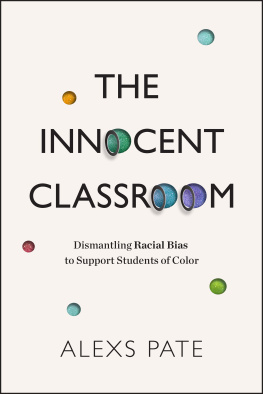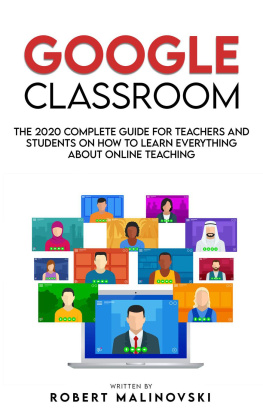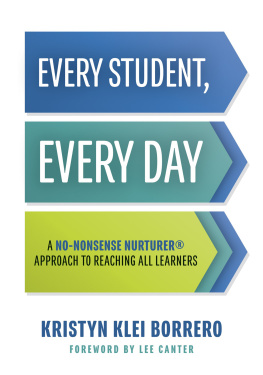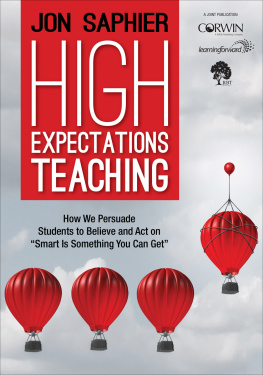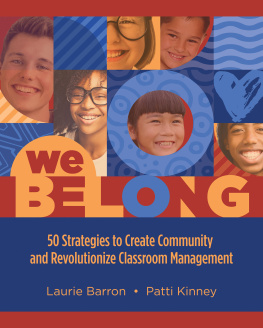Contents
Guide
Pages


Praise for the Innocent Classroom Approach
....................
The Innocent Classroom has reaffirmed my philosophy as a teacher, an administrator, a mom, and a person. I have always felt that strong and genuine relationships with my students were the precursor to future success. It is a fact of life that as educators, we all feel the constant pressure of getting through the curriculum, worrying about standardized test scores, and making AYP. Alexs Pate's passion for fostering children's innocence focuses on creating a school community that prioritizes building, advocating for, and protecting the "good" of each of our children. While I could cite research on the correlation between positive student-teacher relationships and increased student achievement, effort, and personal growth, the day-to-day experiences of the heart are proof enough for me. You, our children, and I will all work harder and achieve more when we know we are valued for our unique "goods" that drive us in all that we do. The Innocent Classroom brings us back to nurturing the soul and heart. With this vital component, our children will succeedboth academically and emotionally. The Innocent Classroom has made me reflect, go deeper, and see what makes each child (and adult) truly unique. I appreciate and applaud Alexs Pate for his dedication in helping all of us find and value the true human spirit within us.
Elementary school assistant principal and former classroom teacher, Omaha, Nebraska
I've never seen a practice or a program that has changed hearts and minds so fast. We haven't even finished our training, but there's been an immediate culture shift.
K8 school principal, St. Cloud, Minnesota
It works. Kids will do things for teachers they love. Our graduation rate has gone up. We are one of the highest graduation-rate growers over the last five years in the entire state of Minnesota and in the metro area. The last few years, we've had about 16-point growth, and we have also made very large gains with all groups within our district. We have closed gaps between our Latino and white students. We have closed gaps between black and white students, our ELL and non-ELL students, and our special ed and nonspecial ed students.
Superintendent, suburban Minneapolis public school district
With Innocent Classroom, you end up with kids who care about each other, kids who can be flexible when you need to change something, kids who can be patient if you are struggling with technology, kids who will do anything for the greater good. When I even start to ask, "Is there someone who could ?" 15 hands go up because they want to help. When you lead with finding innocence, kids who screamed and ran the halls or needed a one-on-one adult at other schools become the stars of your class. When you lead with finding innocence, you get higher test scores five years in a row.
Teacher, Lucy Craft Laney Community School, Minneapolis
Dedication
....................
For my daughter Sxela, her friends, and children everywhere, and the teachers and parents who work hard to save them
Acknowledgments
....................
The concept of the Innocent Classroom sprang from a belief. So many people had to share in that belief for it to evolve, and many more have had to engage and implement it for that belief to become real. My deepest thanks to everyone who has supported this work. I want to especially thank Dr. Matthew Brandt for his initial encouragement and support and Jess Annabelle, who has done the impossible to ensure our success.
My thanks also to all the folks who have been deeply engaged in this effort, including Joseph Leadley, Julian Condie, Adebisi Wilson, Jaimee Wolcott, Fallon Gleason, Lar'Ranz Guider, Iman Hassan, Sami Saltzman, David Mura, J. Otis Powell, June Yoshinari Davis, Damu McCoy, Tom Nelson, Scott Erickson, Craig Green, Tai Coleman, Rob Johnson, Tony Orange, Tameika Williams, Avigdor Edminster, Chris Mangold, Chad Hancock, and Alexandria Delcourt.
I would like to thank the Minnesota Humanities Center for giving me the opportunity to conceptualize and demonstrate the Innocent Classroom training, as well as the Sherwood Foundation and other funders who have supported the districts and schools engaged in this work. I particularly want to thank the early adopters, including Omaha Public Schools, Saint Paul Public Schools, Northside Achievement Zone, Equity Alliance MN, South Saint Paul School District, NECC Early Childhood, Saint Paul Promise Neighborhood, Friendship Academy, Mounds View Public Schools, Minneapolis Public Schools, Richfield Public Schools, and the schools we've worked in in Reno, Nevada; San Jose, California; Providence, Rhode Island; Valley View, Illinois; and Milwaukee and Racine, Wisconsin, for the opportunity to engage their educators. Without the opportunity to work in these environments, we wouldn't have the data to prove the efficacy of our approach.
Last, I want to personally thank Bob Coughlan, Jerry Bexten, Katie Weitz, Dr. David O'Fallon, Casey DeMarais, Sondra Samuels, Dr. Eric Jolly, Ann Mulholland, Jerry Timian, Dr. Nora Murphy, Dr. Eleanor Coleman, Kevin Lindsey, Dr. SooJin Pate, Kate Gipp, Jennifer Tonko, Rose McGee, Dr. Omawale Akintunde, Dr. Tommy Watson, Julianne Schwietz, Eden Bart, Jimmie Johnson, Janice Gilmore, Jeff Hom, Jonah Edelman, Dr. Dan Saltzman, Mary Bussman, Dr. Susan Sencer, Michael Thomas, Michelle Bierman, Nicole Bates, Steve Unowsky, Leadriane Roby, Dr. Jennifer Mueller, Jay Salter, Charvez Russel, Nell Collier, Amy Kellogg, Sherida Britt, Patricia Stockland, Gyanni Scott, Alexs Thompson, and, especially, Rachel Voller. Thanks also to ASCD, especially Allison Scott and Miriam Calderone.
Preface
....................
When I think of children of color, in my head, in my dreamswhen their images are disconnected from cold realitythey appear as I see or saw myself as a child. Curious. Energetic. Smart. Brilliant, even. Innocent. Yes: innocent. Young, gifted, and innocent.
In the beginning, I did not set out on a journey to create a professional development program for teachers. I simply began to meditate on what I had absorbed from what popular culture had to say about me. The truth was that no matter how I saw myself, I always expected I was being seen in a different way, a fragmented sensation referred to by W. E. B. Du Bois as "double consciousness." It is a complex truth, but suffice it to say that I never felt that the world outside my family and friends had the slightest idea of who I was.
I have lived much of my life as a writer. A poet. An artist. And the art I made, the poems and novels I wrote, were mostly about humanizing myself and the people I met on my journey. I was entangled in a reality in which I was always seen through a filter of stereotypes. This affected my life in myriad ways. I have no doubt that negative stereotypes settled into my unconscious and shaped my behavior. I found myself waiting for disaster and feeling a nearly constant sense of what I'm calling, in this context, guilt. The stereotypes that popular culture had constructed about me had gradually led me to act, more often than not, as though they were true. My instinctive reaction to events and people around me seemed more like a programmed response than how I might actually be feeling.
I wanted to be free of that way of being. So I began a yearslong meditation, one that continues to this day, to eliminate that guilt and its relationship to how I lived and its influence on the decisions I made. I wanted to remove that feeling of unspecified culpability, of being a conspirator in my own limitationsto put it simply, my sense of guilt.

